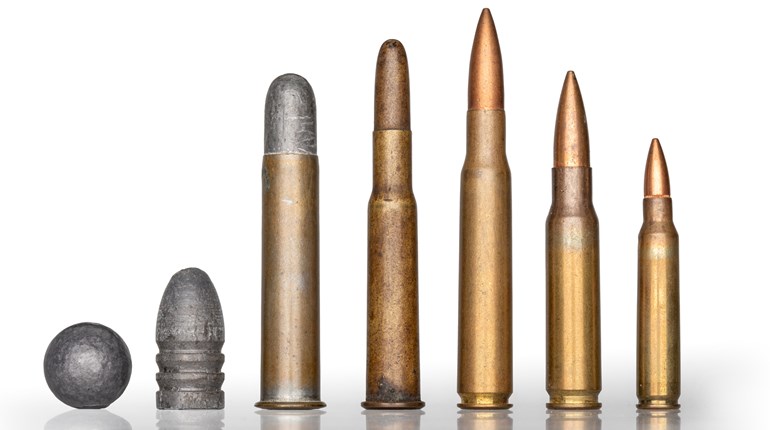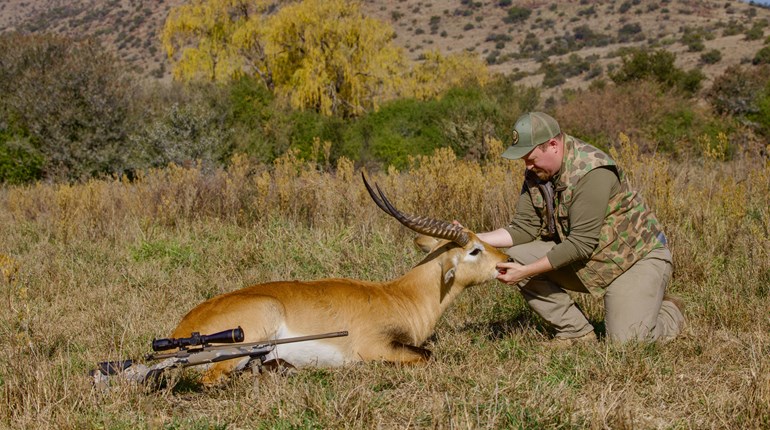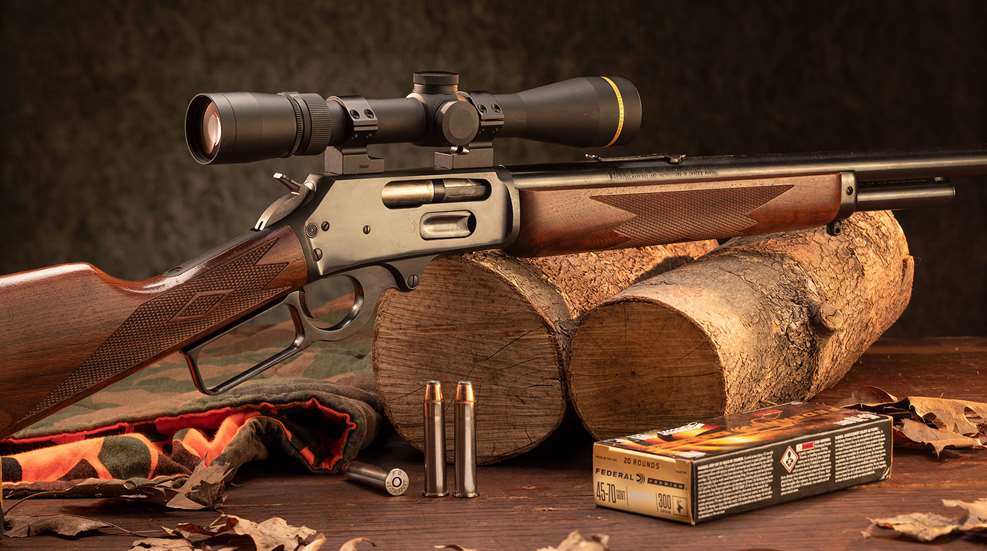
Whiz … . You’d hear the “good ones” before they hit you. Just enough time to close your eyes, if you were smart. A lightning flash, then stinging pain. Those little rubber bands always seemed to find a hole, especially when my little 9-year-old cherub face was poking out for a recon of my brother, Scott’s, enemy fort.
For a few wonderful, welt-filled summers, rubber band gun wars were life for me and my brother. And we took our lives seriously. The basement of our rented suburban home—a large unfinished playground full of DIY wooden storage shelving, plenty of boxes for stacking, futons, couches, blankets, a wood shop and even an old classic European car—was turned into a war zone every weekend as the neighborhood boys gathered to fortify their bases and face off with the latest homemade weaponry and pockets full of rubber. Dad’s workshop was filled with possibility, and from its corners of scrap wood, saws, hammers and coffee cans full of nails, my brother and I would craft the tools of sibling rivalry. Being a few years older and thus more versed in the theories of firearm design and marksmanship, Scott would turn out the most painfully accurate guns our basement ever saw. Lightweight, lightning fast and chambered in the nastiest little bands the world has ever known—high-BC orthodontic bands (acquired from his pimply-faced pals)—his guns were a masterpiece of velocity and childhood cruelty, and they were purpose-built with one target in mind: me.
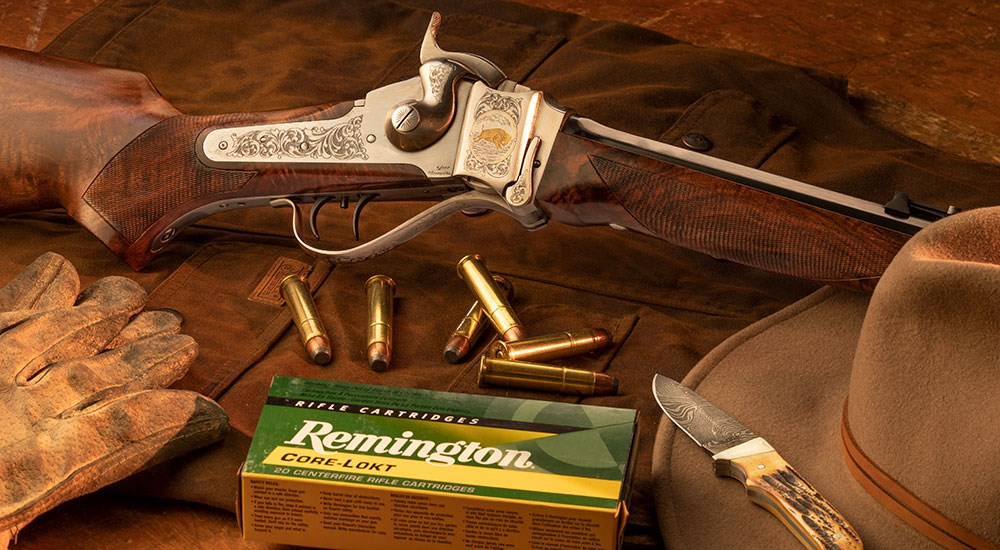 With set triggers, an adjustable rear sight and a heavy, 31-inch octagonal barrel, this gorgeous reproduction 1874 Sharps rifle in .45-70 from Italian gunmaker Davide Pedersoli balances and shoots on par with its looks.
With set triggers, an adjustable rear sight and a heavy, 31-inch octagonal barrel, this gorgeous reproduction 1874 Sharps rifle in .45-70 from Italian gunmaker Davide Pedersoli balances and shoots on par with its looks.
I, on the other hand, didn’t quite grasp concepts of ballistics at that age, and instead followed the “bigger is better” mantra of battlefield theory, consistently turning out from our meager gun shop the two-by-four equivalent of punt guns. Heavy, cumbersome and with the tool marks of apprenticeship, my “big-bore” guns were designed for massive destruction and built to harness the power of the largest and therefore most lethal rubber bands I could think up: the ones found on lobster claws.
As it was, lobsters never made their way through our kitchen, so I had to settle for the large lanky blue bastards they use to control unwieldy lettuce.
Despite the fact that they hit like a lukewarm hotdog—assuming your enemy didn’t duck the shot to begin with—I always believed my guns and those huge rubber bands to be far superior, and my brother had no intention of filling me in on the truth anytime soon. I believed bigger was better, and in rubber band guns, it turns out I was wrong. The same, however, cannot be claimed when it comes to real big-bore rifles. And when it comes specifically to the .45-70 Gov’t., I’ll never concede.
It was in that very basement, probably as my brother and I were snooping for our latest excuse for a grounding, that I first discovered the .45-70. Digging through the crates under Dad’s loading bench, I came across an old Remington ammo box adorned with masking tape covered with my father’s distinctive chicken scratch. The top line read “45.70,” followed by a rash of numbers that meant absolutely nothing to me at that age, and the words “MARLIN ONLY” underlined and in full caps. But it was the last line, Dad’s intended uses for this handload, that grabbed my attention, sending my vivid imagination on a ride that would last for the next 30 years. It read, “Elk, Bear, Tank Load, Trucks.” That box was opened faster than the U.S. Cavalry mail-order catalog. One look at that behemoth round weighing down my hand and I was hooked for life. Bigger was better.
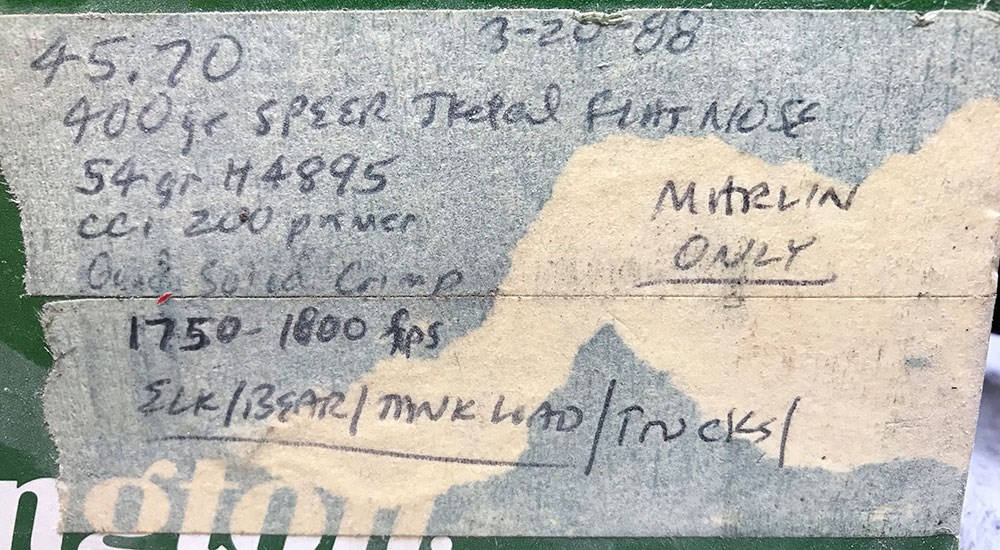 The author knew the old pack rat still had them somewhere, and after a trip down memory lane, his father was able to locate the very tank loads that started it all.
The author knew the old pack rat still had them somewhere, and after a trip down memory lane, his father was able to locate the very tank loads that started it all.
It was 1873 when Uncle Sam first conceived of the tank-stopping cartridge that would eventually become the apple of my eye. Built to be fired from the single-shot “Trapdoor” Springfield, that original load, known technically as the .45-70-405, consisted of a 405-grain, .45-caliber projectile, backed by 70 grains of black powder. Though it was said to be lethal out to 600 yards, it seems that Uncle Sam wanted a bit more distance in his volleys and eventually packed on an additional 95 grains of lead for our boys to throw with the adaption of the .45-70-500. Be it the Trapdoor Springfield, Gatling guns or the various small arms carried by the Army, Navy and others, during the late 1800s, the .45-70 Gov’t., in various bullet weights and designs, was the cartridge of choice for the United States for a variety of purposes. And it was during that time that the .45-70 made its mark on hunters, too. Firing a 500-grain projectile at around 1300 fps, the .45-70 had a near 1,000-yard range and delivered enough energy to take any game in North America. When chambered in a rifle like the 1874 Sharps or the 1886 Winchester repeater, the .45-70 became a buffalo hunter and trapper’s best friend. While a plethora of other cartridges were adopted by the U.S. military and introduced to civilians in the short years to follow, the adaption of smokeless powder and the continued development of hunting bullets allowed the .45-70 to remain in production well into the 20th century. Its subsequent load variety and widespread reputation amongst hunters and PHs as a round capable of taking the largest and most dangerous game on the planet has kept it there for nearly 150 years.
Today, while it’s no 6.5 Creedmoor, the .45-70 cartridge and the rifles that go with it are holding strong, and even regaining some forgotten popularity in hunting circles. Rather than look at this resurgence as the result of some new wave of hunting hipsters latching on to old Redfields and lever-guns for their latest Insta-post fame (let’s be real, the .45-70 is a lot of gun to handle simply for the sake of a nostalgia-generated thumbs up), I think, again, it’s ammunition manufacturers and in turn firearm manufacturers that deserve the credit. From the introduction of smokeless powder, to the development of bonded bullets, to the hard-cast dangerous-game loads from Buffalo Bore, to Hornady’s game-changing LeveRevolution line in 2005 and now the recent release of Federal Premium’s HammerDown ammunition optimized specifically for lever-action rifles, ammunition companies have continued to produce new and improved loads that hunters want to shoot, opening the door for firearm manufacturers like Henry, Mossberg, Traditions, Marlin and others to produce the “updated” .45-70 lever-action and single-shot rifles—and even handguns—we’ve seen in recent years.
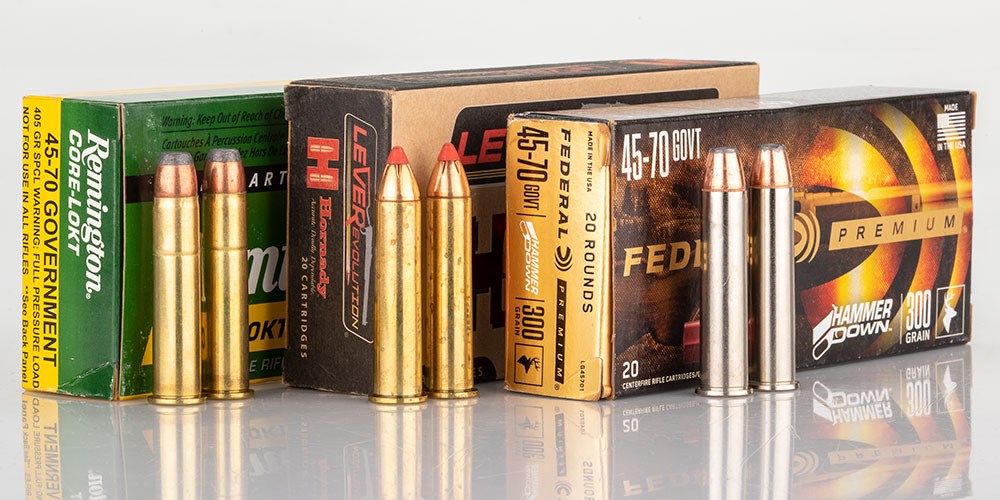
In 2002, at 18 years old, I’d spent enough time ogling Dad’s Marlin, and with my pocket finally bulging with summer-job cash, I headed to the gun store to purchase my very first rifle—my own shoulder-thumping, dinosaur-slaying .45-70. Pop already owned the standard Marlin 1895 with a 22-inch barrel, leaving me the option of either the shorter, 18.5-inch-barreled 1895 Guide Gun or the long, octagonal-barreled Cowboy Action model. Though price ultimately dictated my decision, I was beaming with pride—or perhaps it was with the thought of the jealousy about to ruin my brother’s day—when I came through the door with that stout little bulldog of a rifle, my Marlin 1895 Guide Gun. From then on, it didn’t matter what I was hunting, big or small, my .45-70 would handle them all. We were inseparable.
The Marlin found a welcome home during my college years, hunting the hills around Morgantown, W.Va., between classes and other collegiate obligations. Though we never found much luck, we learned our craft together, and when we left our mountainside school room and headed back home a few years later, we were both better off for the experience.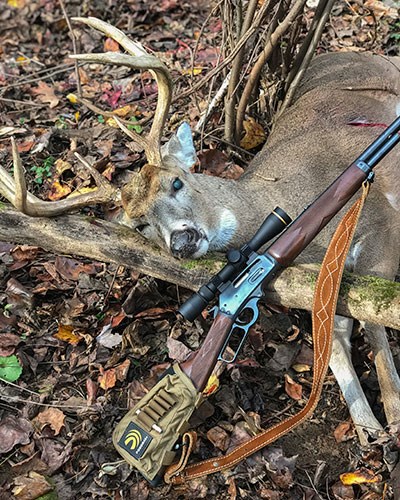
Now, as ashamed as I may be, I begrudgingly must admit to neglecting that rifle in later years. As an editor of this magazine for more than nine seasons now, I’ve been afforded the opportunity to hunt with some amazing firearms in a wide variety of calibers, and without even recognizing the loneliness and despair that must have taken hold of the old girl, I let my beloved grow cold and dusty in the back of the gun safe for far too long. But alas, along came Federal to remind me of the love I’d let fall to the wayside. Like many Americans, the introduction of the company’s HammerDown ammunition optimized for lever-action rifles triggered some deep-seeded urge to rock a lever. As the start of the 2019-20 season got closer, I got wind of HammerDown’s impending release, so with a guilty conscious I eagerly dug my trusty companion from the dark side of the safe, apologized profusely and took her out for a long overdue day at the range. You know the Foreigner song “Feels Like the First Time”? Yeah, it was kinda like that.
While I wasn’t able to get my hands on the new Federal load as quickly as I would have liked, Virginia’s recently introduced early bear season negated I reach for another trusted companion, one from Big Green. Like the original government load, Remington’s .45-70 Core-Lokt load spits a 405-grain bullet. Unlike the government load, however, Core-Lokt is loaded with a controlled-expansion bullet designed for devastating performance on big game. It travels around 1600 fps out of the barrel and hits with a whopping 1,723 ft.-lbs. of energy at 100 yards. On black bears inside 100 yards, it’s more than enough and then some.
Snooping along a familiar power line on the first eve of the new season, I was glassing off the steep side when an almost undetected footfall caught my attention from behind. I turned at the same time a 150-pound black bear stepped out into the clearing and nosed the ground intensely a mere 11 yards away. Startled and caught with my proverbial pants around my ankles, I stared frozen until I was able to remember that I was, in fact, bear hunting, I had a loaded cannon over my shoulder and here was a legal bear ripe for the picking. Taking more time than I should have, I shouldered my rifle, rocked the hammer back and sent it home. The shot picture was perfect, and the shot itself would have been, too, if I hadn’t forgotten to take the safety off. As the hammer landed home, the sound of steel rather than gunfire echoed down the line and my wide eyes locked to the wide-eyed bear now very aware of my presence. He took off into the brush rather than charge me, allowing me just enough time to exhale, frantically chamber another round and try again before realizing my actual mistake. It happens to be a mistake I learned many years ago in college, but alas, years of neglect offered me the chance to learn it again.
Undeterred, feeling a bit sheepish and with the urge of redemption guiding me, I climbed into a treestand overlooking that power line the very next evening and shot a near 350-pound black bear, my first in Virginia and the first for my .45-70. The .405-grain Remington Core-Lokt plowed through hide, flesh and bone like a freight train through a snow berm leaving holes on both sides, and that bear didn’t go 15 yards.
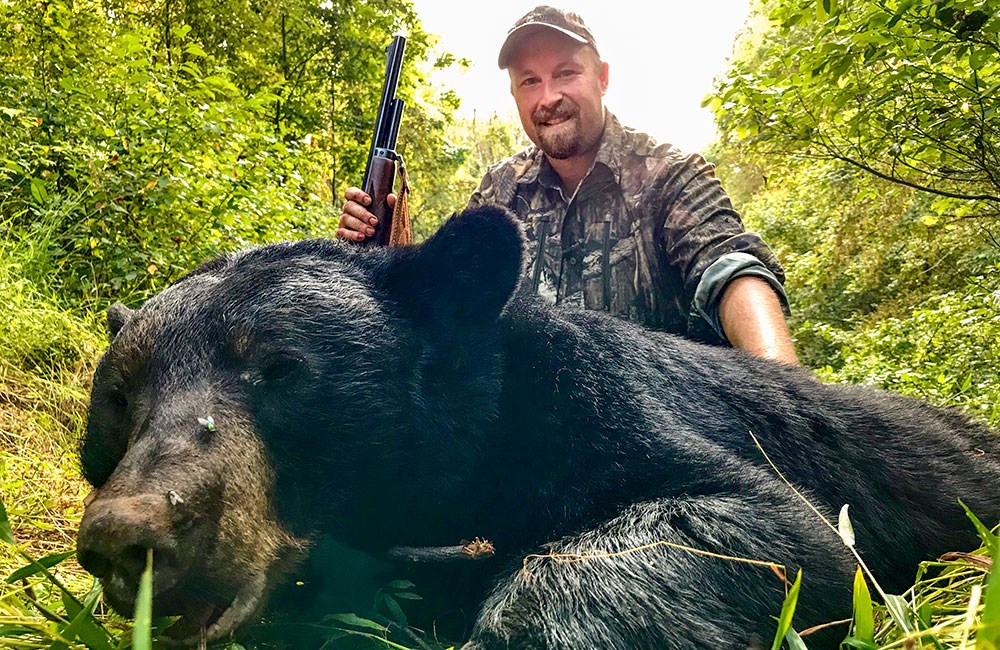 Black irons on a black bear is a tough sight picture to acquire. The author added a Leupold VX-3i 2.5X-8X-36mm scope to his Marlin to beat the shadows.
Black irons on a black bear is a tough sight picture to acquire. The author added a Leupold VX-3i 2.5X-8X-36mm scope to his Marlin to beat the shadows.
It wasn’t until midway through 2020 that I was able to get my grubby hands on the new HammerDown load for the .45-70, and I spent the late summer running it thoroughly through multiple rifles including the Marlin and a couple of Henrys. With its nickel-plated brass case and chamfered case rim, the new load cycled flawlessly, and built with the tight tolerances of Federal Premium behind it, it grouped like I hoped it would, producing sub-inch results from all rifles off the bench. Topped with a 300-grain bonded soft-point bullet, the 45.70 HammerDown load touts a muzzle velocity of 1850 fps, and sighted in for maximum point-blank range from my Marlin, it shoots about 7 inches low at 200 yards, and retains 1,307 ft.-lbs. of dead-right-there energy at that distance.
I was in that same stand on Nov. 14, 2020, the peak of the whitetail rut, with the Marlin stoked with HammerDown and resting comfortably on my lap. It wasn’t long after sunup, and the woods were already busting with rutting activity. By 9 a.m. I’d seen countless does and the few spikes that were driving them absolutely mad, but not much else. It seemed as though things were starting to slow down, and I was just beginning to contemplate pulling a disappearing act on my first sandwich when the distinctive crashing of leaves broke the silence. The doe, at a full sprint, ran across the top of the power line and into the shadows of the adjacent woods.
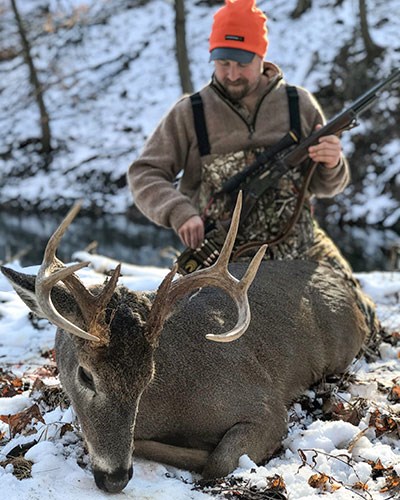 Retracing her line, I caught a large mass of antlers following 40 yards back and closing fast as it broke the treeline and leapt into the clearing. At a jaunt, he made his way to the far edge of the power line and paused to look for his girl, allowing me enough time to acquire a sight picture of the broadside beast about 70 yards out. The hammer dropped, and this time I heard and felt the familiar report and watched as the buck arched its back, tumbled forward and crashed into a blowdown tangle. Upon first contact, I immediately knew it was the biggest buck I or my Marlin had ever taken.
Retracing her line, I caught a large mass of antlers following 40 yards back and closing fast as it broke the treeline and leapt into the clearing. At a jaunt, he made his way to the far edge of the power line and paused to look for his girl, allowing me enough time to acquire a sight picture of the broadside beast about 70 yards out. The hammer dropped, and this time I heard and felt the familiar report and watched as the buck arched its back, tumbled forward and crashed into a blowdown tangle. Upon first contact, I immediately knew it was the biggest buck I or my Marlin had ever taken.
In December of last year, I got the opportunity to hunt with a few friends and took the Marlin and HammerDown loads on a road trip to hunt Ohio’s old mining country. Turns out my good buddy (and former editor of this magazine) Adam Heggenstaller had the same idea, and we both set out amongst those mountains of long-overgrown tailings and countless deep-water ponds with HammerDown-fed Marlin .45-70 lever-action rifles.
The bucks that made this heavily wooded landscape their home over the last 50 years are numerous and large. So numerous, in fact, that it required one’s head to be on a literal swivel in order not to miss an antlered opportunity sneaking by in the freshly fallen snow. It was the last day of the hunt, and I’d seen enough throughout the week that I remained confident in my decision to hold off. My neck was feeling the pain, and I had been watching a group of does to my left for about 10 minutes when I decided it was time for an adjustment. Turning to scan the right side of the stand, I caught a flash of movement in the distance and focused in on the large rump and flicking white tail of a massive buck trotting away from me. He stopped just long enough in a small clearing to let me know he was huge, and then ran off. I swear I heard him laugh.
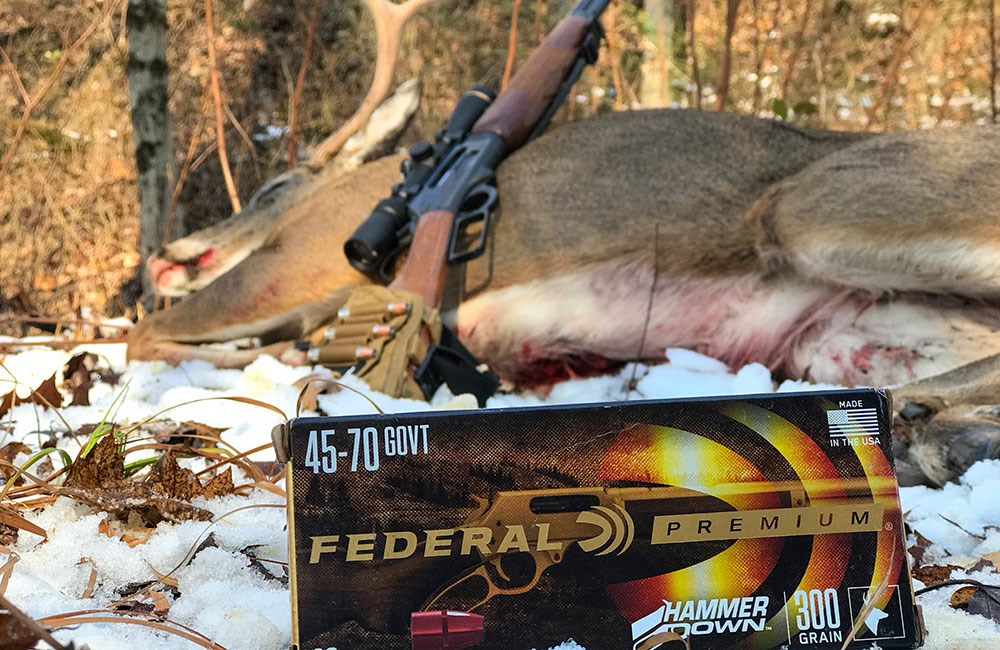
Perhaps it was animosity, perhaps it was the fading light, perhaps it was even the gunshot I heard in the distance and more likely it was a bit of all three, but when another, albeit smaller buck stepped off the hillside a few hours later, I saw a decent rack and didn’t hesitate to let the .45-70 do what it was born to do. He was dead before he hit the ground. Back at the side-by-side, I learned Adam had been facing the right direction when a big-boy came through.
This year, I’ve got a new beauty to hunt with. Two, as a matter of fact. No, I didn’t pick up one of those “upgraded” lever-action rifles—though I wouldn’t hesitate to add a Henry to my personal collection. I picked up a hunting wife instead, and an incredibly gracious new father-in-law. Like my actual father, my father-in-law understands and fosters my love for the .45-70, as well as my love for his daughter, of course. Even so, the gift was way too much, and I wanted so badly to honorably refuse, but when he handed me the beautiful Davide Pedersoli 1874 Sharps reproduction rifle chambered in the elk-, bear-, tank- and truck-stopping .45-70, I knew this would be a love that lasts forever. Let’s just hope my wife doesn’t get too jealous.













